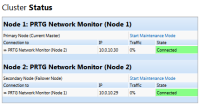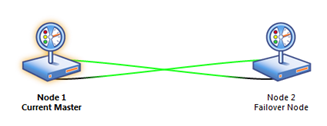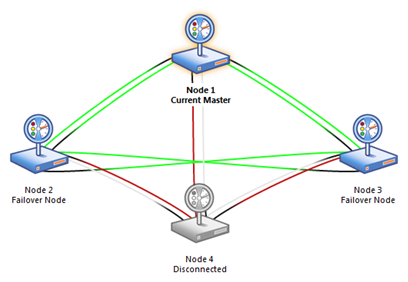While the beta test of PRTG 8 is running we are posting a series of blog articles about new features!With version 8, we introduce a completely new and up-to-date feature: PRTG’s failover clustering.

Simple Failover Cluster
The most common setup is two PRTG servers running “side-by-side” in a single failover cluster. The first node is the Master Node and is responsible for the configuration, management, alerting, and reporting. If this PRTG instance should fail, e.g. due to a server crash or connectivity issues, the second node (i.e. the Failover Node) takes over the master role and continues the monitoring until the original Master Node is back online.

While the second node is in Failover mode, it does not idle around waiting for something to happen. On the contrary: The Failover node monitors the same network in parallel to the Master Node, providing the same data from another perspective. So, for example, the administrator can monitor the Ping time of a device from different “corners” of the local or remote network and compare the values. To access the current status of your monitoring you can connect to the web server of both the Master and the Failover node. Both will show you up-to-date status information and will allow you to access the monitoring results of all other nodes.
Multi Failover Cluster
Using the same clustering technique, the administrator can set up a web of up to 5 nodes, all working together in one fail-safe monitoring environment. If a node fails or the server running the PRTG installation must be restarted, the other nodes continue monitoring, so you can obtain seamless data reports. 
Cluster Features
PRTG’s cluster status page always shows the current cluster status clearly. In a cluster, all nodes are connected to each other, exchanging configuration data. An update of the PRTG software can be installed on any of the nodes —it will be deployed to the other cluster nodes automatically. While every node collects monitoring data in its own database, reports on these data can be generated centrally. The distributed database has another advantage: Should a server running a PRTG node core server crash, losing all data, there is still the monitoring data from all other available nodes, even if—for whatever reason—no backup can be restored for the crashed server.
In Short
PRTG 8's cluster features in short:
- Fail-safe monitoring
- Monitoring data from every node’s perspective
- Distributed data base
- Central reporting
- Central notifications/alerting
- Secure connections between nodes
Beta Test it Today
Why not go and see for yourself? Download the latest Beta version today and have a look! All information can be found on the PRTG 8 Beta web page.
 Published by
Published by 












